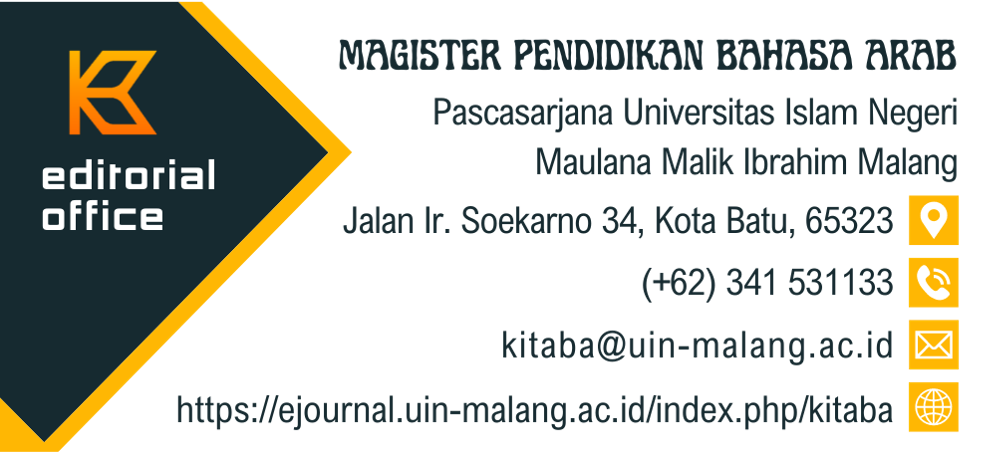Typological Analysis of Digital Indo-Arabic Research Terms Dictionary with a Lexicographical Approach
Abstract
Full Text:
PDFReferences
Abdul Wahab, M. (2017). Peta Perkembangan Leksikografi Arab Di Indonesia: Studi Kritis Atas Kamus Karya Mahmud Yunus. Arabi : Journal of Arabic Studies, 2(1), 19. https://doi.org/10.24865/ajas.v2i1.31
Abraham, L. B. (2008). Computer-mediated glosses in second language reading comprehension and vocabulary learning: A meta-analysis. Computer Assisted Language Learning, 21(3), 199–226. https://doi.org/10.1080/09588220802090246
Hayani, F. (2019). Leksikografi Arab (Sebuah Kajian Linguistik Terapan). Shaut Al Arabiyyah, 7(1), 1. https://doi.org/10.24252/saa.v1i1.7786
Hermawan, A. (2011). Metodologi Pembelajaran Bahasa Arab. PT Remaja Rosdakarya Offset.
Hidayah, N., & Qomariah, U. K. N. (2020). KAMUS TEMATIK SAINS SEBAGAI UPAYA MENINGKATKAN PENGUASAAN KOSA KATA BAHASA ARAB MAHASISWA BIOLOGI. Allahjah, 5(2), 20–28.
Mursid, M. C. (2015). Analisis Teknis Aplikasi Kamus Bahasa Arab–Indonesia Berbasis Web. Probisnis, 8(2), 43–52. http://ejournal.amikompurwokerto.ac.id/index.php/probisnis/article/view/398%0Ahttp://ejournal.amikompurwokerto.ac.id/index.php/probisnis/article/download/398/365
Nugrahani, F. (2014). Metode Penelitian Kualitatif dalam Penelitian Pendidikan Bahasa. In Diglib FKIP Universitas Bantar (Vol. 1, Issue 1, p. 305). http://e-journal.usd.ac.id/index.php/LLT%0Ahttp://jurnal.untan.ac.id/index.php/jpdpb/article/viewFile/11345/10753%0Ahttp://dx.doi.org/10.1016/j.sbspro.2015.04.758%0Awww.iosrjournals.org
Octaviano, A., & Sokma, A. andriyan. (2019). Perancangan Aplikasi Kamus Digital Berbahasa Indonesia – Sunda – Inggris Berbasis Android. Prosiding Seminar Nasional Informatika Dan Sistem Informasi, 3(3), 148–155. http://openjournal.unpam.ac.id/index.php/SNISIS/article/download/3091/pdf
Suktriayu, R. E., Kridalaksana, A. H., & Hatta, H. R. (2017). Aplikasi Kamus Bahasa Paser-Indonesia Berbasis Android. Prosiding SAKTI (Seminar Ilmu Komputer Dan Teknologi Informasi), 2(2), 152–154. http://e-journals.unmul.ac.id/index.php/SAKTI/article/view/764/pdf
Sunarti, L., Ernawati, E., & Affan, M. (2017). Aplikasi Kamus ViKA sebagai Visualitator Kosakata Bahasa Arab untuk Pembelajar Pemula. LISANIA: Journal of Arabic Education and Literature, 1(1), 37. https://doi.org/10.18326/lisania.v1i1.37-55
Taufiqurrochman. (2015a). Pengembangan Kamus Tarbiyah Indonesia–Arab Indonesia.
Taufiqurrochman, R. (2015b). Leksikologi Bahasa Arab. UIN-Maliki Press.
Ya’kub, I. (2016). Metode Penyusunan Kamus. Pustaka Pelajar.
Zahrah, H., Wargadinata, W., & Barry, N. A. (2021). Analisis E-Dictionarry “Arab-Indonesia” yang tersedia di Play Store dengan Pendekatan Leksikologi. Shaut Al-‘Arabiyah, 9(1), 1–10.
الخطيب, ع. (1994). المعجم العربي بين الماضي والحاضر. مكتبة لبنان ناشرون.
DOI: https://doi.org/10.18860/kitaba.v1i1.21080
Refbacks
- There are currently no refbacks.











